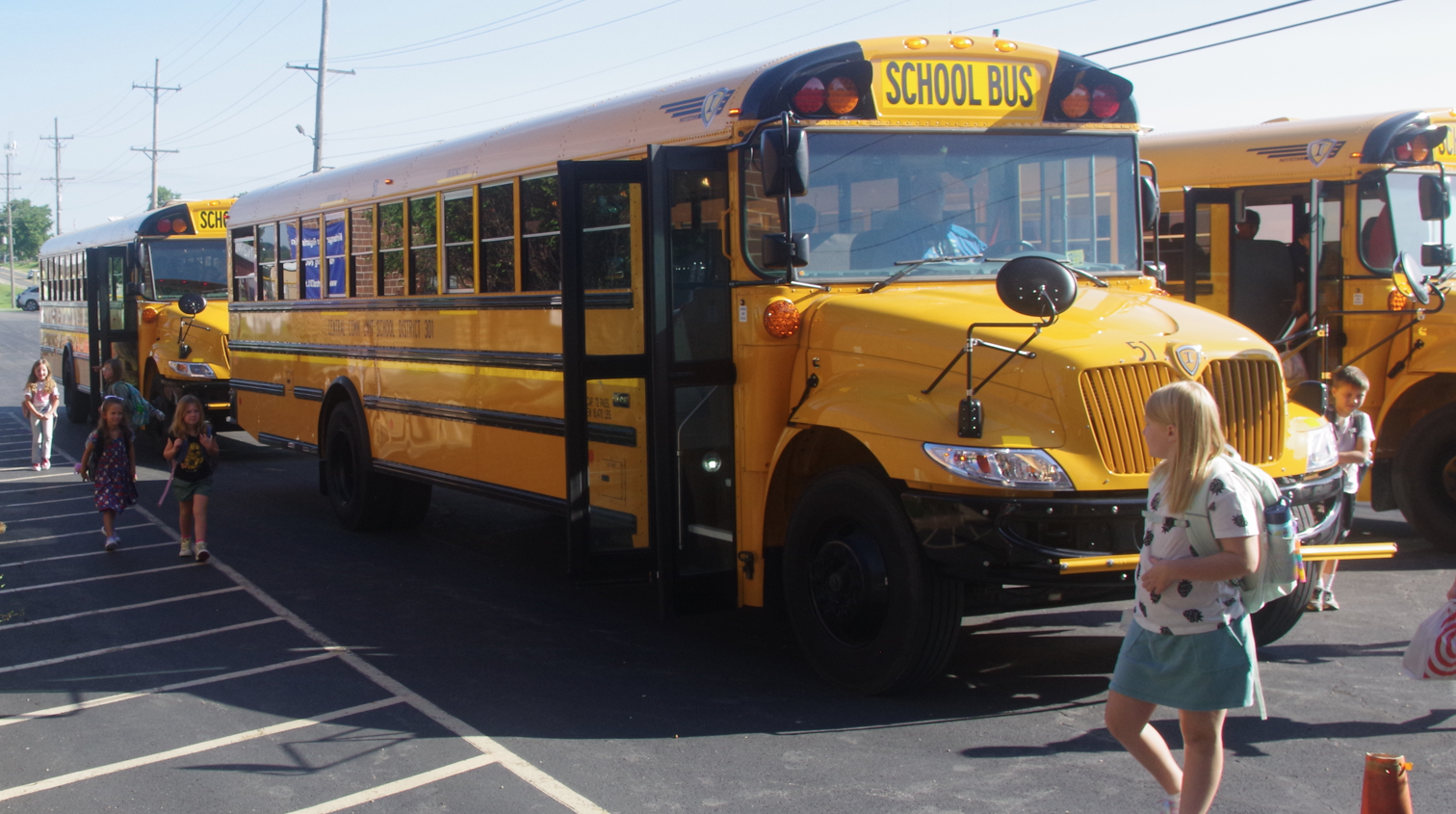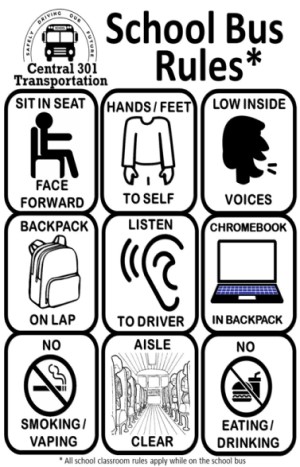
Rules & Policies
Central 301 Transportation Rules & Policies for School Bus Riders
All CCUSD 301 disciplinary and safety guidelines are applicable, including those outlined below.
- Students may only ride their assigned school bus.
- Arrive at your designated bus stop five (5) minutes prior to your scheduled pickup time. Be careful when approaching the place where the bus stops and stay away from the street while waiting for the bus. Do not move toward the bus until the bus has been brought to a complete stop and the driver signals you to board. Enter in single file without pushing. Always use the handrail.
- Be aware of moving traffic and pay attention to your surroundings.
- Dress properly for the weather. Make sure all drawstrings, ties, straps, etc. on all clothinging, backpacks and other items are shortened or removed to lessen the likelihood of them getting caught in bus doors, railings, or aisles.
- Take a seat right away and remain seated facing forward in your assigned seat while the bus is in motion.
- Always be alert and listen for any instructions given by the driver. Be courteous to the driver and other students. Sit with your hands to yourself and avoid making noises that would distract the driver or bother other passengers.
- Windows are to remain at or above the white safety line at all times. Do not throw anything out of the windows. When you are on the bus, keep hands and feet inside the bus at all times.
- Talk quietly on the bus. Refrain from abrupt, loud noises and/or any unnecessary confusion that could divert the driver’s attention from safely driving the bus. Be absolutely quiet when approaching and crossing railroad tracks.
- Refrain from littering, defacing, or destroying bus property. Never tamper with the bus or any of its equipment.
- Assist in keeping the bus safe and sanitary at all times. Keep belongings out of the aisle and away from emergency exits. Eating, drinking, and gum chewing are not allowed on the bus.
- Do not bring any animals on the bus, unless it is a service animal.
- Wait until the bus pulls to a complete stop before standing up. Use the handrail when exiting the bus.
- Take all belongings with you.
- Respect the driver, fellow students, and yourself. Help look after the safety and comfort of smaller children.
- Do not ask the driver to stop at places other than the regular assigned bus stop. The driver is not permitted to alter their route without proper authorization from an administrator.
- Students must sit three (3) in a seat on the school bus when necessary due to the load.
- Cell phones and other electronic devices may be used responsibly on the school bus. Any misuse of these items will result in disciplinary action. Bus drivers are not responsible for devices lost, damaged, or stolen. Examples of misuse include but are not limited to:
- Using device as a camera
- Displaying inappropriate images/website
- Use of inappropriate language
- Use of device for harassment or intimidation
- Tablets, computers, smart phones, smart watches, and other electronic devices must be silenced on the bus unless students use earbuds or headphones and the listener is still able to hear emergency directions.
- Stay out of the danger zone next to the bus where the driver may have difficulty seeing you. Take at least five giant steps (10 feet) away from the bus and out of the danger zone, until you can see the driver and the driver sees you. Never crawl under a bus.
- Walk at least 10 feet in front of the bus if you must cross the street after being dropped off, and wait for the driver to signal to cross the road. Cross the street only after checking both ways for traffic, even after the driver’s signal. Never run in front of a car or bus.
- Never run back to the bus, even if you dropped or forgot something.
- Large objects (i.e., musical instruments, class projects, etc.) need to fit on a student’s lap while being transported on the bus. Items that are too large may not be stowed by the driver. Parents/guardians may need to transport these items to and from school.
The same rules and regulations apply to all bus trips, including for school sponsored trips, athletics, and transportation to and from home and school. Students who are unable to abide by the rules and expectations in order to maintain a safe environment when riding a school bus may face disciplinary consequences.
Restricted Items
Because of the potential for disrupting the school bus driver, certain items are not to be brought on the bus. Some examples of such items could be but are not limited to:
- skateboards
- cameras
- sleds
- snowboards/hoverboards
- laser lights
- in-line skates
- toys
- playing cards
** In some cases, the student may seek approval from the Transportation Director or building administration for special situations (i.e., field trips, athletic trips, etc.).

School Bullying Intervention Plan
Central School District 301 has a School Bullying Intervention Plan in place which complies with the State mandated law. The school bus is an extension of the classroom; therefore, the students are expected to behave on the bus just as they are expected to behave in school. Details of the School Bully Intervention Plan are located in the Parent/Student Handbook. It is important that victims of bullying report incidents of repeated bullying behaviors, even if they are minor. Victims and/or victims’ parents are encouraged to keep track of dates, times, and types of incidents to help facilitate investigations. Our school bus drivers will report any instances they witness, and students are asked to also relay any form of bullying to the driver as well.
Transportation – Walking Requirements
The District has established walking requirements based on state regulations and guidelines.
If a student lives within 1.5 miles from school, he/she can reasonably be expected to walk to and from school, and the district is not responsible to provide transportation. In defining the district’s responsibility to provide transportation, state regulations and guidelines presume that a student should be expected to walk up to 1.5 miles on a “normally traveled” walking path. Walking a footpath will, in most cases, be safer than walking alongside or even in vehicular traffic, which previously had been the only option to busing for virtually all of our students.
The State Board of Education believes that a “normally traveled” walking path should be used in measuring the distance from a student’s home to school for the purpose of determining whether the student lives 1.5 miles or more from school. Article 29 of the Illinois School Code (105 ILCS 5/29-3) states that the distance SHALL BE measured from the exit of the residence property to the point where the students are normally unloaded at the school attended, determined by the shortest distance on normally traveled roads or streets.
